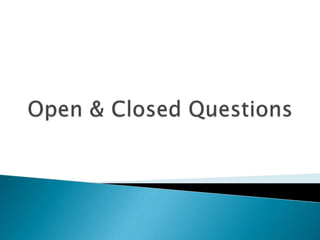Report
Share

Recommended
Recommended
Presentation on questioning

Presentation on questioningJaved Iqbal Student of M.S (Teacher Education) at University of Tennessee USA
More Related Content
What's hot
Presentation on questioning

Presentation on questioningJaved Iqbal Student of M.S (Teacher Education) at University of Tennessee USA
What's hot (20)
Similar to Open & Closed Questions
Similar to Open & Closed Questions (20)
JWI 505 Business Communications and Executive Presence Lect.docx

JWI 505 Business Communications and Executive Presence Lect.docx
Open & Closed Questions
- 2. A closed question looks for specific facts and often only requires one word answer which can be yes or no. “Did you finish your homework?” “What time did that happen?” “Are you going to buy a drink?” “Who won the football match?”
- 3. Closed question are good for finding out specific information. Can help make a decision quickly. Can help gather more information.
- 4. Closed questions are not useful when dealing with emotional situations. Not effective when you want the response to be expressive and communicate feelings. Respondent may think their answers are irrelevant
- 5. An open question allows the respondent to develop their ideas without limiting responses or controlling responses. The questions often require more than one word answers. “What do you think would happen if…?” “Sounds interesting. How does that work?” “How do you feel about that?”
- 6. Sometimes you can help solve problems through open ended questions. Respondents can include more information such as their feelings, attitudes and understanding so true feelings can be received. Can obtain extra and detailed information.
- 7. Difficult to compare answers to questions. Response rate to questions is lower because it takes a longer time to complete questions and questionnaires.